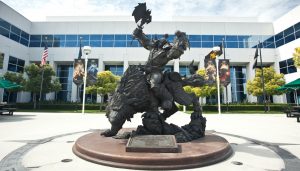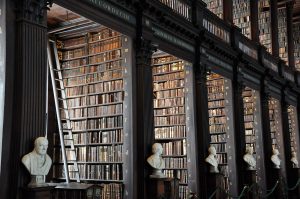Present Past: Sepia Photographs of Library Architecture
by Laura McClanathan
Sepia-tone imparts a timeless nostalgic quality, and a certain stillness, to photography. When the subject is architecture, the removal of all but one color of the spectrum allows the observer to take in more of its evocative details. This selection of digital photographs of library architecture is taken from my blog, A Sepia Lens, where I use modern equipment and an old technique to reveal a timeless essence from a traditional perspective. The modern library, with its long and noble history, bridges the same divide in an ever-evolving dance between “the very old” and “the very new.”1
The cozy wooden chalet on an organic farm is a little-known library on the UC Santa Cruz campus. It is a working private library for the farm apprenticeship program founded by master English gardener and teacher, Alan Chadwick, in 1967. The UCSC campus still retains its rural feel on the edge of an urban environment. Chadwick was called by one of his apprentices “a gardener of souls.”2
The geometric shadows of the foyer of UC Santa Cruz’s McHenry Library speak to the trend of modern architecture in libraries. The bold lines stand in contrast to the softness of the lush natural environment outside its doors. After a renovation completed in 2012, the foyer is now the home of a bustling library café that feeds the hungry academic community and serves as a popular meeting place.
This subject of this 2005 photograph is a pre-renovation fixture of UC Santa Cruz’s McHenry Library, designed in the mid-1960s by John Carl Warnecke. Now just a memory, the spiral staircase at the heart of the library was deemed a fire hazard by current building codes. Only a trace curve in the ceiling is visible to those who remember the iconic feature reaching upward allowing natural light to stream downward through every floor.3
There is life on MARS at University of Nevada, Reno’s Mathewson-IGT Knowledge Center. Filled with print holdings, many of which formerly resided in remote storage, MARS (Mathewson Automated Retrieval System) is a high-tech feature within a Jeffersonian and Monticello-inspired red brick library building. This 2014 photograph captures an Art Deco feeling evoked by the light emitted by the machine speedily retrieving materials.
The Los Angeles Public Library is a historic downtown landmark. Built in 1926, the central building was designed by Bertram Grosvenor Goodhue in the Mediterranean and Egyptian revival style. The inscription below the mosaic pyramid is from Lucretius’ On the Nature of Things (serendipitously rediscovered in a scriptorium in 1417) and is translated “And like to runners hand the lamp of life”—a wonderful metaphor for the books contained within.4
Late afternoon sun casts a magical light on the north façade of UC Berkeley’s reading cathedral, the Doe Library (1911). President of the University of California, Benjamin Ide Wheeler, wrote in 1904, “The Library is a common interest of all the departments. In its prosperity is bound up the scholarly fate of the University. Until we have a great library, properly housed and administered, we cannot have a great university.”5
Elegant details are ubiquitous on the Harvard University campus, and the Widener Library built in 1915, is no exception. The graceful scrollwork of this wrought-iron gate superimposed upon the trees in the distance allows two beautiful views at once. This library was built by a generous donation from Eleanor Widener as a memorial to her son, Class of 1907, who died on the Titanic.6
The oldest freestanding library building in the United States is now home to the South Caroliniana Library, on the University of South Carolina campus. Completed in 1840, this library building designed by Robert Mills survived the Civil War and since 1940 has exclusively housed South Carolina history collections and artifacts. The grand oak tree shading its entrance is dedicated to Robert L. Meriwether, the Caroliniana’s founding director.7
The Page Smith Library is a tiny honor-system library, and peaceful study space, nestled in the center of Cowell College at UC Santa Cruz. One of the stained glass windows sheds light on a dictionary and the still-used card catalog, with one drawer whimsically labeled “CURIOSITY” and a collection ranging from reference works to classic literature. The library was named in honor of Page Smith, Cowell College’s founding Provost.
McHenry Library at UC Santa Cruz was rededicated in 2012 after a long-awaited renovation. Seen here in dappled afternoon light, the redwood sign was given a newly prominent place though still close to the beloved cherry trees on the north side of the library. Dr. Dean E. McHenry, a well-known educator who played a key role in a 1955 investigation at the University of Nevada, Reno, was UCSC’s founding chancellor in 1965. McHenry’s vision encompassed the library as the intellectual heart of the university.8
Notes
1. Linda Main, “Manuscript Study” (Handout received in History of Books and Libraries with Dr. Linda Main, San Jose State University, Spring 2014).
2. “Alan Chadwick: A Gardener of Souls,” accessed July 4, 2014, http://alan-chadwick.org.
3. John Chase, The Sidewalk Companion to Santa Cruz Architecture (Santa Cruz, CA: Museum of Art & History, 2005), 276.
4. “Lucretius – Quotes,” The European Graduate School, accessed July 4, 2014, http://www.egs.edu/library/lucretius/quotes/.
5. “Doe Library, 1911,” UC Berkeley Library, History Room, accessed July 4, 2014, http://library.berkeley.edu/give/historyroom/panel3.html.
6. “Widener Library History,” Harvard College Library, accessed July 4, 2014, http://hcl.harvard.edu/libraries/widener/history.cfm.
7. “About the South Caroliniana Library,” University Libraries, South Caroliniana Library, accessed July 4, 2014, http://library.sc.edu/socar/about.html.
8. Betty Glass, “Friends of the University of Nevada Helen G. Wittenberg, Secretary Records 1952-1957,” University Archives, accessed July 4, 2014, https://knowledgecenter.unr.edu/univarch/colls/ac22.html.
 Laura McClanathan is an MLIS graduate student at San José State University. She is a professional photographer whose work has been featured in academic publications and a central coast gallery. Laura is a long-time library assistant and alumna of UC Santa Cruz. Inspired by her work experience at the University of Nevada, Reno and UCSC, she is specializing in reference and instruction in academic libraries. To reach Laura, contact her through LinkedIn or via email.
Laura McClanathan is an MLIS graduate student at San José State University. She is a professional photographer whose work has been featured in academic publications and a central coast gallery. Laura is a long-time library assistant and alumna of UC Santa Cruz. Inspired by her work experience at the University of Nevada, Reno and UCSC, she is specializing in reference and instruction in academic libraries. To reach Laura, contact her through LinkedIn or via email.













Wonderful!!!